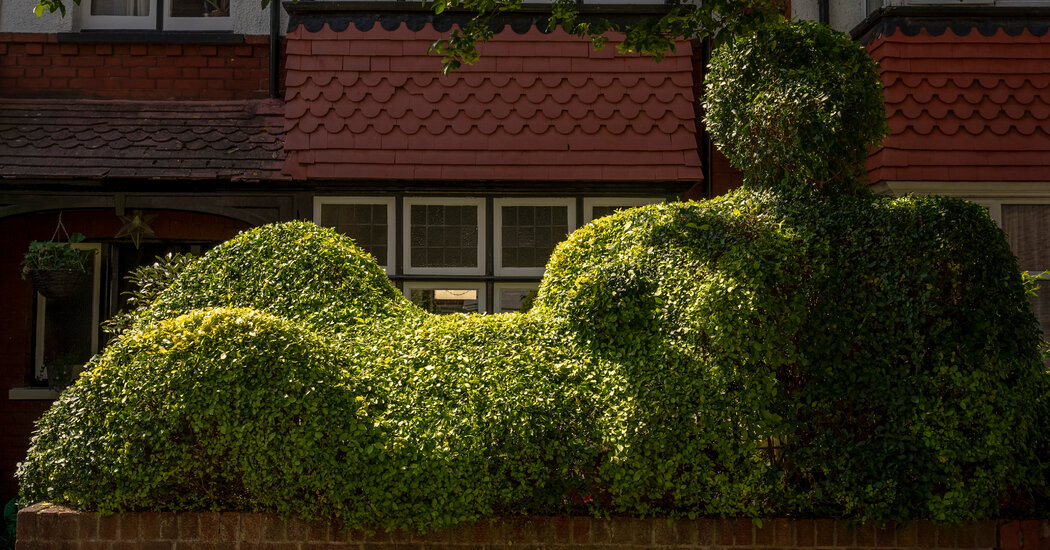One recent evening, when Tim Bushe decided to trim some hedges, he attracted more attention than usual for a routine garden job.
Walkers slowed to take photos and ask questions. Neighbors stepped over piles of cut leaves to thank him. A driver honked his horn and gave a thumbs-up.
Mr. Bushe is used to attention. It happens every time he gives his two giant, furry elephants a haircut. They are just one in a series of hedges on residential streets that Mr. Bushe has transformed from overgrown plants into whimsical creations.
His hedge menagerie includes two cats, a squirrel, a hippopotamus, and a fish. There's even, experimentally, a naked woman lying down. He hopes a giant rabbit will join them this summer.
Its hedges have delighted residents for years and baffled others who have stumbled upon them. They have even garnered reviews like local landmarks on Google Maps, from the no-nonsense (“Well-kept”) to the effusive (“My life is now complete after seeing this beautiful hedge”).
Mr Bushe, 70, a graduate art and architecture major, has built many things over his long career, from schools and shops to houses and offices. But it is perhaps his mischievous hedges dotted around north London that are most intriguing.
“I see how much joy they bring,” said Mr Bushe, who donates his hedge-trimming earnings to environmental causes. “They elevate the urban landscape in a very positive way.”
“Why not do something playful?”
Hedges have a long history in Britain, used to enclose land as early as the Bronze Age and enjoying explosive popularity during an agricultural revolution in the 18th century. And the idea of shaping hedges has deep roots, too: the world’s oldest topiary garden, founded in 1694, is at Levens Hall, a manor house about a five-hour drive north of London.
“Hedges provide much-needed shelter for buildings, people, farms and livestock,” said Guy Barter, chief horticulturalist at the Royal Horticultural Society, adding that they thrive in the British climate.
In more recent times, Mr. Barter said, a well-trimmed garden hedge has come to symbolize a certain kind of aspiration: a serious homeowner who takes his neighborly duties seriously. A poorly maintained hedge, however, has been considered serious enough to spark legal controversy.
But wilder hedges are also becoming fashionable, Mr. Barter said. “Hedges are very eye-catching and an easily noticeable way to show who you are,” he said.
“It’s a bit like you have a white picket fence and something’s curling up in the middle,” said Tim Alden, a friend of Mr Bushe’s who was inspired to prune his hedge in east London into a dog-shaped topiary.
There was something about the surprising strangeness of a dog-shaped hedge, he said, that seemed to inspire notes of joy in his mailbox. “Why not do something playful every once in a while,” he said, “for no other reason than to make us smile?”
Mr. Bushe is choosy about his commissions, only accepting projects close to his home in north London. “I really like the idea that there’s a collection of these around where I am,” he said. (And yes, he’s aware that his name is more than fitting for the work. “Maybe it was my destiny,” he said.)
It all started about 15 years ago, with an overgrown hedge in his front garden, Mr Bushe said. His late wife, Philippa, asked if he could sculpt a cat for her. “I thought a cat might be complicated,” he said.
Instead, another shape came to mind as he was trimming the hedge: a train. Then he tried carving the head of a lizard-like monster. Neighbors began asking him to turn their hedges into shapes, too, including a huge set that he claimed would turn into perfect elephants.
“That's when it really happened,” he said. Eventually his wife took her cat into the hedge across the street.
But the journey from flora to fake fauna requires patience, perseverance and the luxury of time. Mr Bushe begins with initial cuts to shape the hedge. Then, it has to grow. It can take three years or more for the trimmed hedges to take on their final form.
“For example, I could end up with only one ear and have to wait years for the other to grow,” he said.
Bringing his designs to life is a process more like sculpting than gardening. “I can visualize it in my head, the whole thing,” he said. “It’s just a matter of finding it.”
Protect your pets
Unlike marble, the common privet hedge quickly loses its shape: it requires several prunings a year to maintain its shape. “People get very upset when it gets hairy,” Mr Bushe said.
But, he added, they are harder to maintain as they get older. Nature will be the final arbiter of how long these hedges will live. Two previous elephants were lost to honey fungus, and the dog hedge is losing its leaves to some hungry vine weevils. “I live in fear that they will be attacked,” Mr Bushe said.
One recent evening, Mr. Bushe enlisted his dog, Spike, and Mr. Alden to transform what had begun to look more like woolly mammoths than elephants. With electric trimmers in hand, they hacked away, mounds of leaves blanketing the ground. Legs, ears, and trunks sharpened to the sight.
Simon Massey was among the neighbors who came to express their appreciation. “It’s just a beautiful piece of art,” he said, adding that he’s seen all sorts of people come to the neighborhood to visit and photograph the creatures.
Abdirshid Obsiye, a science teacher, had walked past Mr Alden's dog-shaped hedge many times before noticing it had been listed as a tourist attraction online. He added a tongue-in-cheek review of his own, calling it “an inspired piece”.
Mr. Obsiye said he appreciated the effort that went into the sculpting. But he also saw the fun side of the mundane becoming appealing. “Some people wonder why a hedge is a tourist attraction?” Mr. Obsiye said. “Why not? Who made the rules?”





